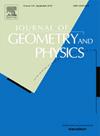Kac-Moody algebras on soft group manifolds
IF 1.2
3区 数学
Q1 MATHEMATICS
引用次数: 0
Abstract
Within the so-called group geometric approach to (super)gravity and (super)string theories, any compact Lie group manifold can be smoothly deformed into a group manifold (locally diffeomorphic to itself), which is ‘soft’, namely, based on a non-left-invariant, intrinsic one-form Vielbein μ, which violates the Maurer-Cartan equations and consequently has a non-vanishing associated curvature two-form. Within the framework based on the above deformation (‘softening’), we show how to construct an infinite-dimensional (infinite-rank), generalized Kac-Moody (KM) algebra associated to , starting from the generalized KM algebras associated to . As an application, we consider KM algebras associated to deformed manifolds such as the ‘soft’ circle, the ‘soft’ two-sphere and the ‘soft’ three-sphere. While the generalized KM algebra associated to the deformed circle is trivially isomorphic to its undeformed analogue, and hence not new, the ‘softening’ of the two- and three-sphere includes squashed manifolds (and in particular, the so-called Berger three-sphere) and yields to non-trivial results.
软群流形上的Kac-Moody代数
在所谓的(超)引力和(超)弦理论的群几何方法中,任何紧致李群流形Gc都可以平滑地变形成一个群流形Gcμ(局部微分同构于Gc本身),它是“软的”,即基于非左不变的、固有的一形式Vielbein μ,它违反毛雷尔-卡坦方程,因此具有不消失的相关曲率二形式。在基于上述变形(“软化”)的框架内,我们展示了如何从与Gc相关的广义KM代数开始,构造与Gcμ相关的无限维(无限秩)广义Kac-Moody (KM)代数。作为一种应用,我们考虑了与变形流形(如“软”圆、“软”二球和“软”三球)相关的KM代数。虽然与变形圆相关的广义KM代数与其未变形的类似物是平凡同构的,因此并不新鲜,但二球和三球的“软化”包括压扁流形(特别是所谓的Berger三球)并产生非平凡的结果。
本文章由计算机程序翻译,如有差异,请以英文原文为准。
求助全文
约1分钟内获得全文
求助全文
来源期刊

Journal of Geometry and Physics
物理-物理:数学物理
CiteScore
2.90
自引率
6.70%
发文量
205
审稿时长
64 days
期刊介绍:
The Journal of Geometry and Physics is an International Journal in Mathematical Physics. The Journal stimulates the interaction between geometry and physics by publishing primary research, feature and review articles which are of common interest to practitioners in both fields.
The Journal of Geometry and Physics now also accepts Letters, allowing for rapid dissemination of outstanding results in the field of geometry and physics. Letters should not exceed a maximum of five printed journal pages (or contain a maximum of 5000 words) and should contain novel, cutting edge results that are of broad interest to the mathematical physics community. Only Letters which are expected to make a significant addition to the literature in the field will be considered.
The Journal covers the following areas of research:
Methods of:
• Algebraic and Differential Topology
• Algebraic Geometry
• Real and Complex Differential Geometry
• Riemannian Manifolds
• Symplectic Geometry
• Global Analysis, Analysis on Manifolds
• Geometric Theory of Differential Equations
• Geometric Control Theory
• Lie Groups and Lie Algebras
• Supermanifolds and Supergroups
• Discrete Geometry
• Spinors and Twistors
Applications to:
• Strings and Superstrings
• Noncommutative Topology and Geometry
• Quantum Groups
• Geometric Methods in Statistics and Probability
• Geometry Approaches to Thermodynamics
• Classical and Quantum Dynamical Systems
• Classical and Quantum Integrable Systems
• Classical and Quantum Mechanics
• Classical and Quantum Field Theory
• General Relativity
• Quantum Information
• Quantum Gravity
 求助内容:
求助内容: 应助结果提醒方式:
应助结果提醒方式:


